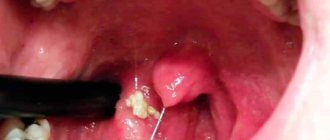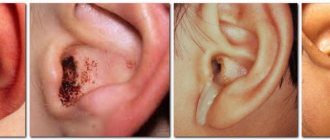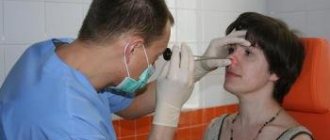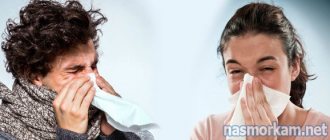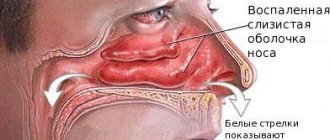Illustration copyright Getty The loss of the sense of smell deprives a person of not only the ability to perceive smells and aromas. It entails the most dramatic consequences - what exactly, a BBC Future correspondent found out.
Nick Johnson scans the menu at the White Dog Cafe, a jumble of tiny rooms and closets in Philadelphia's university district.
“Empanadas (pies – Ed.
) with beef... I wouldn't mind them.
But the beef stew would be wasted for me. I avoid ordering fish and chips (fish fried in batter and with French fries - Ed.
) - for me, all fried food tastes the same. I think I'll choose a taco (Mexican flatbread) with fish. I know I’ll get the heat of the hot spices and a little bit of pineapple flavor, the heat of the pepper with the avocado, something that will make you feel something in your mouth.”
He orders tacos and we get draft beer. It's called Nugget Nectar (native nectar - Ed.
), it is brewed at a local craft brewery where Johnson has worked for the past 10 years.
(Other articles on the BBC Future website in Russian)
Nugget Nectar was once his favorite beer. “It has a lovely balance of sweetness and hops. But now,” he says, and his face darkens, “for me it is nothing more than a semblance of its former essence.”
He can describe the smells of beer - the aroma of pine needles, citrus, grapefruit. But he is no longer able to feel that bouquet.
Image copyright iStock Image caption Our noses may be able to detect many more smells and aromas than we realize
People do not flatter themselves with the idea that they have some kind of unusually acute sense of smell, especially compared to animals. But scientific research shows that smells can have a powerful subconscious effect on human thoughts and behavior.
People who lose their ability to smell due to accident or illness say they experience a sense of great loss that affects their lives in ways they never imagined.
Perhaps we do not rank smell very high in the ranking of our senses - and most likely because we are hardly aware of the role it plays in our lives. Until we lose it.
Johnson, now 34, can pinpoint the exact day he lost his sense of smell. This happened on January 9, 2014. He played hockey with friends on a frozen pond in the town of Collegeville, Pennsylvania, where his parents live.
What results could we achieve if we took a closer look at the world around us?
“I've done this a million times,” he recalls. “I was slowly rolling backwards, and then my skate fell into a furrow in the ice. My legs gave way. I fell backwards and hit the right side of the back of my head. I passed out, and when I came to, I was already in the ambulance. People were bending over me, blood was flowing from my ear.”
He ruptured his eardrum and his skull was cracked in three places. There was a brain hemorrhage and he was shaken by convulsions. “I had no idea what was happening to me.”
He recovered quickly, was cleared to drive six weeks later, and returned to work as regional sales manager at the Tröegs brewery.
Soon he found himself among the participants in a meeting dedicated to a new type of beer. “We were tasting beer, and colleagues asked, can you smell the hops in it? But I didn’t feel it. Then I tasted it. The guys said: “It has such a pale biscuit taste,” but I didn’t feel this taste. Then I tried another variety, more hoppy, but even now I didn’t notice the aroma. Then something seemed to click in my head.”
The stress caused by the injury and the use of various types of medications can probably explain the fact that he did not immediately realize that he had lost his sense of smell. At first the discovery came as a shock. Now, however, he clearly understands what this led to.
Loss of pleasure from eating and drinking is a common complaint for people who have lost the ability to smell.
Image copyright Thinkstock Image caption It pains Johnson that he can no longer smell his baby
With the tongue we feel the taste of sweet, salty, bitter, sour and umami ( the so-called fifth taste, which is given to food by some flavoring additives, for example, monosodium glutamate - Ed
).
The perception of more complex flavor combinations, say grapefruit or barbecued steak, depends on smell. But for Johnson and many others like him who cannot smell, there is another absolute loss.
At the time of Johnson's incident, his wife was eight months pregnant with their second child.
Over lunch, he said, “I sometimes joke that I can’t smell my daughter’s diapers. But I don’t smell her own either. She woke up at four o'clock in the morning. I held her in my arms and we lay in bed. I know what my son smelled like when he was a baby and when he grew up a little. Sometimes he didn’t smell very good, but I have a memory of the wonderful smell of a child associated with him. I never had to experience anything like that with my daughter.”
How does this happen
According to various estimates, the number of individuals who cannot smell is several percent of all adults. This means that millions of human beings live without a sense of smell.
Some were born this way, others lost this ability during their lives. One of the most common causes of loss of smell in young people is chronic sinusitis or inflammation of the mucous membrane of the paranasal sinuses.
Image copyright Thinkstock Image caption Our tongue senses strong flavors, but we also need smell to complete the picture
Another risk factor is that the olfactory nerves terminate in the upper parts of the nasal cavities, the turbinate mucosa and the nasal septum, making them very vulnerable to environmental toxicants and various infections.
In older, but not elderly, people, problems with smell are more likely to occur due to viral infections. Even a common cold can be dangerous, but no one can say why some people lose their sense of smell because of it and others do not.
By the age of 70-80 years, few people manage to avoid a significant weakening of their sense of smell. The body has the ability to regenerate: nerve cells constantly die and are replaced by new ones. However, with age, this process slows down, and areas of the surface of the nasal mucosa lacking olfactory receptors become more extensive.
Nick Johnson likely suffered catastrophic damage to his olfactory nerves. As they travel from the nose to the brain, these nerves penetrate a porous plate of bone called the ethmoid bone.
When his head hit the ice, the sudden displacement of the brain inside the skull could have caused the olfactory nerves to be severely damaged or even severed by bone, preventing signals from the nose from reaching the brain.
I don't smell
When the nose cannot smell, how to treat it? Should I immediately contact a specialist or is this a trifle and will go away on its own? Why did this happen? These and other questions arise in the head if a person loses one of these important sense organs.
Don't worry ahead of time. First, you need to understand the principle of operation of this respiratory organ and the reasons that could lead to its failure to continue to function as usual.
Stable operation of this sense organ is simply necessary. Without the ability to recognize odors, a person can be in great danger even at the everyday level, for example, due to a gas leak. Moreover, problems with the sense of smell may indicate a brain tumor.
Anosmia (loss of smell) can be complete or partial. In fact, this olfactory organ has a very complex structure, which is why, even at this moment, it remains incompletely studied.
Special receptors work to recognize aromas, to which the smallest molecules of odorous substances enter through the nasal passages. The information received becomes an electrical signal and enters a part of the brain, where the final output occurs, which we recognize as “smell.”
If your nose has stopped smelling, there can be a huge number of reasons for this. Due to its complex structure, its stable operation directly depends on even minor details, and the loss of smell is caused by any disturbance in the penetration of air into the nasal passage.
Among other things, the sense of smell deteriorates with age and from hunger, and its severity even depends on the time of day , for example at night, the brain practically does not recognize odors. In certain situations, the inability to recognize aroma is a congenital pathology.
There are several basic concepts that describe the loss of smell:
- full;
- partial (the ability to detect some odors);
- specific (without the ability to determine any specific odor);
- absolute hyposmia (decreased sense of smell);
- partial hyposmia (decreased sense of smell for specific odors);
- dysosmia (incorrect perception of smells).
The most common cause of loss of smell remains blocking the access of microscopic odor particles directly to the mucous membrane. This can happen for various reasons:
- Inflammatory processes.
- Polyps.
- Deviation of the nasal septum.
- Physical trauma.
- Neoplasms.
- Immersion of olfactory hairs in secretions.
Rhinitis is the main and most common reason for the inability of odor molecules to access the mucous membrane. The body secretes an additional amount of mucus to fight microbes, which causes swelling in the area where the receptors are located.
Among other things, loss of smell may remain even after a runny nose has been cured . This is often due to long-term use of special drops, which are supposed to relieve swelling, but in the end, if abused, they themselves provoke it.
Normally, the nose should regain its ability to perceive odors within 7 days . What should you do if a week has passed and you still can’t smell it? You need to see a doctor as soon as possible , because there is a high risk of damage to the olfactory nerves.
In addition to rhinitis, the mucous membrane can also swell with:
Self-medication is strictly forbidden , as this can lead to irreversible negative health consequences, including complete loss of smell.
In cases where the nose breathes but does not perceive odors, the problem often lies in malfunctions or even damage to the cells that perceive odors. The reason for this may be the following factors:
- neoplasms;
- viral infections;
- chemical poisoning;
- radiation therapy for cancer treatment;
- tumor in the brain;
- harmful chemical fumes.
There are cases when the loss of the ability to smell is irreversible. This often occurs due to physical trauma to the skull and damage to the recognition center of smell. Most often, such injuries occur during an accident.
Absolute loss of smell can occur in other cases:
- Kallmann syndrome;
- cancer tumor;
- congenital diseases;
- neurosurgical operations and therapy;
- use of neurotoxic drugs.
If for a long time, for no apparent reason, there is no sense of smell, you need to contact an otolaryngologist (ENT) as soon as possible . Only a qualified specialist can maintain the stable functioning of the organ.
An otolaryngologist, using special techniques, will be able to determine the true cause of the malfunction of the olfactory organ, after which he will prescribe special treatment. The approach must be comprehensive : surgical intervention, physiotherapy, special medications.
Among other things, the specialist must develop an individual nutrition system to restore the sense of smell. It is especially beneficial to consume foods that contain vitamin A and zinc:
- orange and yellow vegetables;
- dairy products;
- beef;
- sunflower or pumpkin seeds;
- liver;
- chicken eggs;
- legumes
If the otolaryngologist cannot detect any disorders that may directly or indirectly affect the loss of smell, it is necessary to visit a neurologist. The problem may be a failure in signal transmission to the cerebral cortex. Often the problem is nerve damage, cancer, Parkinson's disease, or multiple sclerosis.
Diabetes mellitus may also be a cause of dysfunction of the olfactory organ. If treatment is not started in time, damage occurs to the nerve cells that process data about incoming odors.
If you suspect diabetes mellitus, you need to go to an endocrinologist, who will make the appropriate diagnosis and prescribe the appropriate procedures. Now knowing which nose does not smell, you can start treatment on time and avoid more serious complications.
When you have a runny nose, air access to the olfactory receptors is blocked. This means that air particles carrying aroma, due to snot, have difficulty penetrating into these places, resulting in loss of smell and taste.
People who suffer from chronic runny nose, sinusitis and sinusitis are especially susceptible to this condition. Adenoids, polyps, allergies, nasal septum defects and neoplasms in the nasal cavity significantly worsen the situation.
A decrease in the sense of smell always occurs in the second phase of a runny nose during a viral infection, when nasal itching and sneezing are replaced by copious liquid discharge and congestion. This happens for two reasons:
- The secretions envelop the walls of the nose, preventing air from entering them.
- Some viruses block the functioning of receptors.
If, a week after the cold, the condition worsened, the temperature began to rise, the sense of smell and taste disappeared, persistent nasal congestion and headaches appeared, the disease may have been complicated by sinusitis (sinusitis). Sinusitis is an inflammation of the mucous membrane of the paranasal sinuses. The mucous membrane of the sinuses swells, the secretion stagnates and turns into pus.
Microorganisms that cause sinusitis destroy the epithelium, so taste and smell signals simply stop reaching the brain. This is the cause of loss of smell.
Vasoconstrictor drops can be dripped no more often than every 4–6 hours and no more than 3–4 times a day. The duration of treatment for most drugs is 3 days. But it is not uncommon for people to abuse these medications and instill them often and in large quantities.
With prolonged and frequent use of vasoconstrictor drugs, the muscular layer of the nasal vessels ceases to function independently, and the nutrition of the vessel wall is disrupted.
You can also dry out the nasal mucosa by irrationally using astringent drops - Collargol and Protargol.
The sense of smell may disappear temporarily during an allergic rhinitis. This happens due to swelling and an abundance of liquid secretions, which prevent air from coming into contact with the olfactory receptors.
If the sense of smell has disappeared due to allergies, then first of all you need to get rid of it with the help of antihistamines and hormonal drugs.
It’s not scary if the sense of smell has disappeared during pregnancy (against the background of vasomotor runny nose), menstruation, or after taking oral contraceptives. The reason for this is hormonal changes, after which everything returns to normal.
The cause of loss of smell may be changes in the nasal cavity, accompanied by discharge:
- polyps;
- adenoids;
- large curvature of the nasal septum;
- tumors;
- hypertrophy of the nasal concha.
To restore your sense of smell, you need to get rid of the listed anatomical defects. It is possible that this is only possible with the help of surgery.
The sense of smell and taste disappears in people who work in the production of toxic substances and come into contact with paint and varnish products, petroleum products, vapors of various acids, etc. This condition, called anosmia, or complete loss of sense of smell, may or may not be accompanied by a runny nose.
In addition, active and passive smokers also often complain that they have lost their sense of smell. Receptors can die completely, and it can be almost impossible to restore their original functions.
To get rid of this scourge, you need to eliminate a runny nose and improve the flow of mucus from the nasal cavity.
First of all, you need to limit yourself to using nasal drops. Instead, it is better to use physical procedures, for example, electrophoresis, phonophoresis, UV irradiation of the nose and pharynx, bioptron. If you urgently need to improve your breathing, you need to accustom yourself to using saline solutions, which are good at eliminating the symptoms and causes of the disease. The minerals and natural components they contain significantly improve the functioning of the nasal mucosa.
- You need to do gymnastics every day - strain and relax your nasal muscles for ten minutes. You need to keep your nose tense for at least a minute.
- Massage the wings of the nose.
- If the sense of smell has disappeared and there is a loss of taste, you need to do warm-ups. It is recommended to warm your nose with a blue lamp; if you don’t have one, you can use a regular student lamp. Warming is carried out at a distance of 25 cm, warm for 10 minutes, once a day for a week.
- Rinse your nose daily with pharmaceutical saline solutions - Delphi, Aquamaris, Humer.
- You can drip Pinosol oil drops into your nose.
Attention! For treatment, it is prohibited to use vasoconstrictor drops, sprays and combination drops containing a vasoconstrictor component (Polydex, Vibrocil).
- You need to do steam inhalations over water with the addition of lemon juice, lavender and mint oil. Do them daily, the number of procedures is 10. For inhalation, you can prepare a decoction of sage, calendula, nettle or mint, with the addition of fresh garlic juice. You need to cover your head with a blanket and breathe over the steam for 15 minutes.
- Insert cotton swabs soaked in honey into your nose for 20 minutes.
- If your sense of smell has disappeared, you can breathe over the smoke from burning wormwood, garlic or onion peels.
- Inhaling pungent odors: horseradish, onions, mustard will help restore the taste.
- It is useful to inhale the vapors of menthol oil or Star balm.
- Make hot foot baths with the addition of mustard, eucalyptus, and pepper. They improve blood circulation, effectively cope with runny nose and congestion, and drive away colds, especially if you take hot baths before bed.
To avoid losing your sense of smell and taste, you need to take care of your health and follow the following recommendations:
- do not delay treatment of runny nose and colds;
- during an epidemic of viral diseases, rinse your nose with saline solutions, decoctions of chamomile, and calendula;
- avoid contact with allergens if allergies are diagnosed;
- take care of strengthening the immune system;
- when working with harmful substances, use protective masks and respirators;
- follow safety rules when playing sports.
Loss of smell after a runny nose does not always occur and not in everyone. It is not normal and requires treatment. Therefore, if your sense of smell has disappeared and has not recovered a couple of months after recovery, then it is not recommended to hesitate - you need to go to an ENT doctor.
How does smell work?
Johnson sniffs heavily at the contents of his glass of Nugget Nectar beer, once his favorite. Volatile chemicals rising from the surface of the liquid penetrate deep into his nostrils and reach the upper part of the nasal cavity, which is responsible for the perception of odors.
Then he takes a small sip, and these substances fall from the larynx into the same part of his nose. So far everything is going as expected.
Further. The molecules are absorbed into the mucus in the nose. This is very important for those substances that, by definition, must be odorous.
Now no one will undertake to say, by looking at a molecule, what it will smell like, or whether it will smell at all. What we do know is that if a substance is naturally odorous, its molecules must evaporate easily so that they can be airborne and inhaled. In addition, they must dissolve in the mucus in order to be detected.
Image copyright Thinkstock Image caption The nerve endings of the olfactory receptors are hidden in the nasal mucosa
This is exactly what happens to healthy people who sniff beer, or their own baby, or their partner's T-shirt: they develop a kind of "olfactory image" of the beer or the person, a complex aromatic whole that is barely conscious.
The nerve endings of the olfactory receptors are hidden in the nasal mucosa. These nerve cells lead directly to the brain.
And although we have millions of such cells, there appear to be only about 400 types, each associated with a specific molecule.
The number of cell types remains a matter of debate. Some believe there are no more than 100 of them.
Based on the sequence of activation of different types of receptors, when I sniff Nugget Nectar, I understand that it is beer.
. Johnson doesn't smell anything - the fall damaged or even killed his olfactory nerves, so his brain doesn't receive any signals about the smell of the drink.
Until Johnson suffered his injury, he had a very sensitive nose. Unlike me, he could easily distinguish Nugget Nectar from other beers. This ability comes with experience.
People's reputations are tarnished by the fact that they sniff relatively little
After the received odor signal is processed, this information is transmitted to various parts of the brain, including those responsible for memory and emotions, as well as to the cortex, where the thinking process occurs.
We can quickly learn to match the pattern of receptor activation with the source of the odorant molecules.
Until recently, there was an idea that people were able to detect no more than 10 thousand different odors. However, these ideas have undergone radical revision, according to Joel Mainland, who researches the fundamental principles of smell at the Monell Center for the Study of the Chemical Senses in Philadelphia, Pennsylvania (which is one of the world's leading institutes specializing in taste and smell).
According to a recent paper published in the journal Science, humans are capable of detecting more than a trillion odors. There are some problems with the methodology of this study, and the reliability of the figure itself is controversial, but Menyland believes that we are clearly underestimating our abilities.
Due to the nature of his job, Johnson had to undergo all kinds of sensory training to improve his perception of smells and tastes. All other people, too, presumably, have inexhaustible possibilities, hidden for the time being.
Yes, dogs are famous for their ability to detect the scent of a person across the field. When Mainland was still a graduate student, his supervisor suggested he look into whether it was possible to teach people the same thing. As it turned out, yes, it is possible.
Image copyright Thinkstock Image caption Cows have more olfactory receptors than dogs
Dogs have more olfactory receptors than humans. However, as Mainland points out, cows have more of them than dogs - about 1,200 versus 800 - but this does not mean that cows have a keener sense of smell.
In this sense, the reputation of people is tarnished by the fact that they smell relatively little, and this exercise, if repeated regularly, could develop the sense of smell.
What results could we achieve if we took a closer look at the world around us?
“I can’t smell” and “CT scan of the lungs” are trending: queries in Yandex as a mirror of the pandemic
Rospotrebnadzor counted more than 5.5 thousand cases of COVID-19 infection in almost four million Tatarstan Photo: BUSINESS Online
Rospotrebnadzor statistics: WAS THERE AN EPIDEMIC?
Rospotrebnadzor counted just over 5.5 thousand cases of COVID-19 infection in almost four million Tatarstan. Such data were recently announced by the head of the republican department of the supervisory agency, Marina Patyashina, .
It follows from them that only every 685th Tatarstan resident became infected with coronavirus, and in terms of incidence rates, the republic is in 81st place out of 85 regions of Russia. However, during the same panel, doctors openly spoke about a large number of cases where the diagnosis is made only based on the clinical picture, and Rospotrebnadzor tests show a negative result. Such patients are taken to the same COVID hospitals and treated according to the same protocol as “official” coronavirus patients. Data on how many there are is not officially published. “Every week, almost 600 cases of pneumonia are diagnosed solely by the presence of changes on a computed tomography scan,” Patyashina said. It is easy to calculate that this is approximately 85 cases per day.
The fact that regional authorities have no reason to show all their cards is not surprising: there is also a certain pressure from the federal center, which judges the effectiveness of local leadership by numbers, and a desire to give themselves a free hand in lifting restrictive measures. However, ordinary people still need some guidance in order to make life plans and understand why, in fact, they are asked to continue to take precautions.
“Last week I needed to go to the city, and so I returned in a trolleybus. There were 28 people there. I was the only one wearing a mask and gloves. Four had a mask under their chin, not even at mouth level. The rest all felt great, sitting next to each other, and two of them were coughing in the trolleybus,” Lyubov Avdonina, . But perhaps the whole point is that she was the only one in the entire trolleybus and was aware of the true scale of the problem, because if you believe that during the entire pandemic in Tatarstan only 43 patients died from coronavirus, then the threat does not seem so serious, especially against the backdrop of 3,928 people who died from all causes in May alone.
However, there are indirect ways to understand what is happening. On July 15, Medium portal user Alexander Dragan published a material that caused quite a wide resonance entitled “How to see an epidemic if it is carefully hidden. Experience of five Russian regions." He analyzed search queries in Yandex and Google, including in Tatarstan. There, according to the author of the study, his relatives suffered from coronavirus. Dragan, relying on open data, argues that the number of specific “coronavirus” Internet requests (a specific type of treatment or diagnosis) has increased along with the lifting of strict anti-epidemiological restrictions.
If you believe that during the entire pandemic in Tatarstan only 43 patients died from coronavirus, the threat does not seem so serious, especially against the backdrop of 3,928 people who died from all causes in May alone Photo: BUSINESS Online
METHODOLOGY: HOW AND WHAT WERE COUNTED?
BUSINESS Online conducted its research on Tatarstan, based on the same method. We studied in detail the situation with queries on the topic of COVID-19 in the Yandex search engine in the five largest cities of the Republic of Tatarstan: Kazan, Naberezhnye Chelny, Almetyevsk, Nizhnekamsk and Bugulma. The search engine does not provide information on other localities. For the study, we took the period from March (then the epidemic was just approaching the borders of the republic) until July 26 - the last reporting week, information on which is now provided by Yandex. We used data from the domestic search engine, among other things, because its American competitor Google does not provide exact regional values and the absolute number of queries. You can check all our calculations yourself: here is a link to the service. Enter a query and see the result by switching between the “By region”, “Query history” tabs, etc.
We collected our requests into two groups. The first was called “Symptoms,” which are specific both to a wide range of diseases and specifically to COVID-19. There are five queries in this group: “ lost sense of smell ”, “ can’t smell ”, “ can’t taste ” (all three are specific to coronavirus). And also the general request “ temperature 37 ” and “ frosted glass lungs ” - this is the name of the symptom that accompanies COVID-19 and is determined by computed tomography.
We called the second group “Treatment and Diagnosis”. There are four requests. These are “ lung CT ” and the sister query “ lung computed tomography ”, as well as “ measure saturation ” and “ pulse oximeter ”. A request related to saturation (the level of oxygen saturation in the blood) is one of the determining factors when deciding on hospitalization. As a rule, when the saturation level is below 90, the patient is ordered to be admitted to the hospital, explained several BUSINESS Online interlocutors who have recovered from COVID-19. A pulse oximeter is a device that precisely measures the level of saturation. You can use it at home. It was on sale even before the pandemic, but since it began it has become one of the most requested devices on the Internet.
However, we do not claim that the popularity of search queries exactly corresponds to the dynamics of morbidity. It is quite possible that not only the patients themselves, but also their relatives and friends, as well as those simply curious, search for symptoms and diagnostic methods online. But still, the request for “lung CT scan” is much less idle than, for example, “coronavirus symptoms.” The query “I can’t smell anything” is also more likely to be entered by someone who has encountered a real symptom. At the same time, we must take into account that what matters first is the dynamics, because for every person who entered a request, there are a certain number of those who did not enter.
On March 30, a self-isolation regime was introduced in Tatarstan. By that time, the topic “CT of the lungs” accounted for 80 requests per week, for “computed tomography of the lungs” - only 21 Photo: © Tatyana Makeeva, RIA Novosti
KAZAN
In the capital of the Republic of Tatarstan, the first abnormal surges in user interest in COVID-related topics began in early March, but not a single patient with coronavirus in the Republic of Tatarstan was officially recorded at that time. We can assume that this is the effect of media interest - COVID-19 became a perfect storm, all media reported about it.
Perhaps the most indicative marker of interest in the new virus is “lung CT” and “lung computed tomography.” On March 30, a self-isolation regime was introduced in Tatarstan. Before this, the information that it is computed tomography that allows one to establish the clinical picture of the disease did not arouse so much interest. In March, the topic “lung CT” accounted for 80 requests per week, and “lung computed tomography” – 21.
During the self-isolation regime - in April and until the end of the May holidays - the popularity of these requests increased. For example, on the first request - from 375 in the first week of self-isolation to 463 in the last week.
Everything changed two weeks after the residents of the republic were released from their homes. After a small but well-founded increase in the request for “lung CT,” on June 1, its popularity jumped to almost 1 thousand requests per week. Further - more: the very next week “lung CT” was searched for in Kazan more than 1.6 thousand times. Then for four weeks in a row this request remained at a level of at least 2 thousand requests per week. A slight decline occurred in the period from July 20 to July 26, when Kazan residents searched for “lung CT” “only” 1,781 times, which is still several times higher than the level of the self-isolation era.
The pulse oximeter was of interest to Kazan residents both before the start of the pandemic (a one-time surge in March to 800–900 search queries per week), and since the beginning of June, just a couple of weeks after self-isolation was lifted. Since then, the number of requests has dropped below 600 only once. In the last two reporting weeks of Yandex, 960 and 852 citizens were interested in this request.
The pulse oximeter was of interest to Kazan residents both before the start of the pandemic (a one-time surge in March to 800–900 search queries per week), and since the beginning of June, just a couple of weeks after the lifting of self-isolation Photo: BUSINESS Online
Kazan residents were not interested in measuring saturation until March 23, when 10 requests were made in a week. A surge of interest in measuring blood oxygen saturation occurred in the last week of April, when Yandex recorded 53 requests, after which the number of requests rarely exceeded 20, but from April 15 it began to grow again and already in the period from June 22 to 28 reached a figure of 41.
Kazan users were searching for unique queries for COVID symptoms - “I can’t smell”, “I can’t taste” and “I’ve lost my sense of smell” even before the outbreak. For example, from October 14 to October 20, 2019, Yandex was asked about the loss of smell 120 times. The increase in user interest in these symptoms occurred at the beginning of the self-isolation period. Already on April 27, a characteristic growth began for the query “lost sense of smell,” which was searched 108 times, and the peak was observed from July 6 to July 12 — 1,095 times. The picture is similar for the other two requests. On April 27, “I can’t smell” was searched 152 times, and in the second week of July - 766; for the query “I can’t taste,” the values were 48 and 421, respectively.
Kazan users were searching for unique queries for COVID symptoms - “I can’t smell”, “I can’t taste” and “I’ve lost my sense of smell” even before the epidemic began. Photo: BUSINESS Online
A characteristic sign of frosted glass in the lungs was also searched for even before the start of the pandemic, but extremely rarely the number of requests rose to 10. However, from April 6 to April 12, Kazan residents entered the query “frosted glass lungs” 392 times. Perhaps they were just curious people who decided to see what the term meant. There were more than 100 requests on this topic only from June 15 to 21 and from July 6 to 12 - 164 and 112, respectively.
The query “temperature 37” has traditionally increased since the last week of July 2020, when it showed a value of 307 searches, but from March 9 it increased from 921 to 2,226 by the beginning of April, after which it began to decrease and in the period from May 11 to 17 showed 1,064 search. The next peak occurred with a surge of interest in the loss of taste and smell for the period from July 6 to July 12, when the number of requests increased to 1,514 times. Over the past two weeks, there has been a decrease in interest in this symptom to 932 requests.
In the city, interest in computed tomography of the lungs during the period of self-isolation was moderate. In the first week of April, requests for “lung CT” and “lung computed tomography” were made 11 and 8 times, respectively Photo: BUSINESS Online
NABEREZHNYE CHELNY
In the city, interest in computed tomography of the lungs during the period of self-isolation was moderate. In the first week of April, searches for “lung CT” and “lung computed tomography” were made 11 and 8 times, respectively. From April 20 to April 26, “lung CT” already showed 123 requests, and later decreased slightly and did not show more than a hundred requests for two weeks.
But after the official lifting of self-isolation, residents of Naberezhnye Chelny became actively interested in ways to diagnose coronavirus. If from May 11 to 17, “lung CT” and “lung computed tomography” were searched 191 and 24 times, respectively, then from June 15 to June 21 there were 1,520 and 264 requests. This could be attributed to one-time interest, if the trend did not continue for the next two weeks, when Naberezhnye Chelny users searched for “CT lung” 1,466 and 1,284 times, and “computed tomography of the lungs” - 183 and 205. Now search activity is decreasing, and in the last reporting week from July 20 to 26, requests dropped to 448 and 58.
Interest in pulse oximeters also arose in March. Until March 16, the number of requests for this device did not exceed 26 per week, after which it increased to 150, and in the period from March 23 to 29, even to 214. Let us recall that it was during that period that official data on methods for diagnosing the disease began to appear. An increase in interest in the device has again appeared since the lifting of the self-isolation regime: from May 11 to 17, the number of requests was 184, from June 8 to 14 - 241, from June 15 to 21 - 273, from June 22 to 28 - 316, from June 29 to July 5 - 223. As you can see, the picture completely repeats the dynamics of the queries “lung CT” and “lung computed tomography”.
Measuring the level of saturation did not concern the city until March 13, when there were single searches for this request. But since the second week of March there have been 10 searches at once. The same number of times they searched for information was from May 11 to May 17, and from June 15 to June 21 there were 23 requests. The rest of the time, the number of requests rarely reached 10.
Queries for elevated temperature had their own peak graph, which practically did not coincide with the data for other search phrases Photo: © Alexey Kudenko, RIA Novosti
If we talk about characteristic symptomatic queries, then until April 20, “lost sense of smell” was searched no more than 27 times a week, “I don’t smell” - no more than 51, “I don’t feel taste” - no more than 17. From April 27 to May 3, visible a characteristic increase in interest to 79, 62 and 24 requests, respectively. In the second week of June, “I lost my sense of smell” and “I can’t smell” were searched 566 times, “I can’t taste” - 337.
Chelny residents were practically not interested in the query “frosted glass light” until the period from April 6 to April 12, when this phrase was entered in the search 68 times, but the very next week interest dropped to 6 queries. It woke up again from the first week of June, when requests were made 40 times, the next week - already 64 times, and the peak of interest occurred in the period from June 22 to 28 - 86 times.
Queries for elevated temperature had their own peak graph, which practically did not coincide with data for other search phrases. Until March 15, there was a standard pattern of seasonal growth in requests, not exceeding 312 cases per week, but from March 16 to 22, their number increased to 404, a week later - to 618, a week later - to 864, after which the intensity began to decrease. The next sharp increase in searches for the phrase “temperature 37” began in the last week of May, when the number of requests was 454, and the peak occurred from June 22 to June 28 - 736 requests.
In Almetyevsk, interest in the symptoms of COVID-19 appeared in two waves. “Lung CT scans” began to be actively searched since the beginning of self-isolation, and from April 13 to April 19 a peak of 24 requests was reached Photo: © Ilya Pitalev, RIA Novosti
ALMETYEVSK, BUGULMA AND NIZHNEKAMSK
In Almetyevsk, interest in the symptoms of COVID-19 appeared in two waves. “Lung CT” has been actively searched since the beginning of self-isolation, and from April 13 to April 19, a peak of 24 requests was reached. The second wave began in June, when there were 13 requests in the first week, 86 from June 29 to July 5, a peak of 121 requests in the second week of July, and in the last two reporting weeks, interest did not fall below 100 requests per week. A similar picture, but with smaller numbers, is observed for the queries “computed tomography of the lungs” and “pulse oximeter”.
The symptomatic requests of Almet residents are characterized by only one wave. It began on June 1, when restrictions officially began to be lifted in Tatarstan. The search for “lost sense of smell” increased from an initial 25 times a week to 113 times from June 29 to July 5. Similar indicators for “I don’t smell” were 27 and 87, respectively, for “I don’t taste” - 14 and 37, for “frosted glass light” - 4 and 13, respectively.
In Bugulma, the increase in requests for COVID-19 diagnostics began quite recently. If before June 15, “CT lungs” were searched no more than 12 times a week, then from the reporting week the number of requests increased to 20. And even in the last reporting week - from July 20 to July 26 - the number of requests remained at 21. Likewise, interest in pulse oximeters: from June 15 to 21 - 8 requests, from June 22 to 28 - 14, from July 6 to 12 - a peak value of 19 searches. The symptomatic requests of Bugulma residents show a similar picture: an increase in characteristic requests since June 8. For example, “lost sense of smell” increased from single values to 10 per week, and the peak occurred in the period from June 29 to July 5—28 times. As of the last reporting week, 12 requests were recorded.
Symptom requests - similar to diagnostic ones - from users from Nizhnekamsk began to grow in early June. In particular, “lost sense of smell” showed 97 requests in the first week of June, the peak was reached from July 6 to 12 — 152 requests Photo: “BUSINESS Online”
Nizhnekamsk residents became interested in diagnosing coronavirus during self-isolation. If in the first two weeks “lung CT” and “lung computed tomography” were searched for only a few times, then from April 13 to April 19 the first request increased to 21 times and rarely dropped below, but the real surge of interest occurred in June and July. From June 8 to June 14, “lung CT” was searched 82 times, a week later – 120 times, and the peak occurred on July 6–12 – 170 times. In the last two weeks, the figure has not dropped below 100 requests. In the same period, “computed tomography of the lungs” began its ascent with 14 queries, a week later reached a peak of 26 and now again shows single interest. The search for “pulse oximeter” had a fairly flat pattern, starting with 41 queries between March 16-22, peaking at 67 June 22-28, and showing a value of 56 queries in the most recent reporting week.
Symptom requests - similar to diagnostic ones - from users from Nizhnekamsk began to grow in early June. In particular, “lost sense of smell” showed 97 requests in the first week of June, the peak was reached from July 6 to 12 - 152 requests, and in the last reporting week - 33. Similar pictures for “can’t smell” and “can’t taste”. But “frosted glass lungs” turned out to be interesting for Nizhnekamsk residents at the beginning of self-isolation, when from March 6 to 12 there were 20 requests. In other weeks, interest ranged from 0 to 12 requests per week.
The statistics of requests for Tatarstan as a whole repeats the picture that we see in the largest cities of the republic. The most revealing search is “lung CT” Photo: © Alexey Mayshev, RIA Novosti
WHAT DO “COVID REQUESTS” SAY ABOUT TATARSTAN AND HOW ARE THE NEIGHBORHODS ARE GOING?
The statistics of requests for Tatarstan as a whole repeats the picture that we see in the largest cities of the republic. The most revealing search is “CT scan of the lungs.” In March, interest in the request did not exceed one and a half hundred clicks per week, but a week after the announcement of the self-isolation regime it soared to 500 and did not fall below. The so-called media interest in the request lasted throughout the “quarantine”, but this request passed the psychological mark of 1 thousand only at the end of spring - from May 25 to May 31, “lung CT” was searched 1,102 times. Let us remind you that mandatory self-isolation was lifted two weeks earlier.
Then the graph only grew: after a week, CT scans were searched 1,982 times, after another 7 days - 2,643, after - 3,859, and then for three weeks in a row - more than 4 thousand times weekly! This period includes the period from June 22 to July 12. Coincidence or not, almost two weeks earlier, verandas and terraces of bars and restaurants were opened in Tatarstan, the negative epidemiological effect of which was spoken about by our sources in white coats. Later, the statistics dropped slightly: the next week shows 3,510 requests, and the last reporting week (July 20–26) - “only” 3,011. Yes, judging by the graph, the peak of interest in “lung CT” has indeed been overcome, but so far the popularity of the request is still the same many times higher than the era of self-isolation.
The queries “lost sense of smell”, “can’t smell” and “can’t taste” almost exactly repeat the “lung CT” graph. Adjusted for scale. These queries also began to reach their peak popularity on June 1 - 1,505, 1,325 and 688 queries, respectively. The increase relative to the last week is almost 2 times in both cases.
In general, since the beginning of summer, the number of requests for “I can’t smell” in Tatarstan did not drop below 1 thousand until July 20, when this request was searched 824 times. At the same time, “I don’t feel the taste” was entered 404 times - the minimum figure since the beginning of June, but still slightly higher than in the spring. “Loss of sense of smell” has been of interest to Tatarstan residents at least 1.5 thousand times weekly since the first day of summer, but the popularity of the query has also declined since July 20—“only” 884 clicks.
The Nizhny Novgorod region is one of the country's leaders in the number of officially infected with coronavirus. She has 4th place and more than 24 thousand officially infected Photo: Photo: © Roman Vladimirov, RIA Novosti
For comparison, we analyzed the statistics of neighboring regions of the Volga Federal District, comparable in population. These are Bashkortostan, Samara and Nizhny Novgorod regions. In the capital region of the district, the statistics for the request “lung CT” look somewhat more complicated, but a little more smoothly and structured. Judging by the graph and data, interest in “lung CT” among Nizhny Novgorod residents arose on April 13, i.e., a couple of weeks after the announcement of mandatory self-isolation of citizens. Then Nizhny Novgorod residents searched for this query 1,722 times in 7 days. For comparison: a week earlier - 904. Since May 18, interest in this request has not dropped below 2 thousand clicks. However, the peak value of 2,863 requests (and this was from June 15 to 21) is still lower than the “highest point of interest” in Tatarstan - 4,577 in the period from June 29 to July 5.
Let’s add one more detail: the Nizhny Novgorod region is one of the country’s leaders in the number of officially infected with coronavirus. It has 4th place and more than 24 thousand officially infected. For comparison: in Tatarstan, judging by data from Rospotrebnadzor, there are not even 6 thousand sick people.
By the way, symptom queries such as “I can’t smell” and “lost sense of smell” in the Nizhny Novgorod region also follow the curve of Tatarstan: they reached a plateau of more than 1 thousand queries per week from the beginning of June.
Bashkortostan (31st place in the country and 6.8 thousand infected), on the contrary, judging by the graph, is just reaching the peak of residents’ interest in the symptoms and diagnostic methods of COVID-19. For example, this conclusion helps to draw the most widespread specific request “lung CT” - its curve in Bashkortostan has been steadily growing since June 8, when the request was searched 1,155 times. The peak value of 4,925 requests was reached from July 20 to July 26, the last week for which Yandex disclosed statistics. Problems with the sense of smell and odors have been of interest to Bashkortostan residents since June 29: then both queries climbed up in popularity and have remained at a level of at least 1,300 clicks for three weeks now. During the same period, residents of the republic suddenly became interested in the pulse oximeter (remember, it measures oxygen levels). The device is becoming more and more popular: if at the end of June it was interested in just under 700 times, then then 1,040, 1,296 and 1,493 times, respectively.
The Samara region (30th place and a little over 7 thousand infected) reached a plateau in the popularity of “lung CT” in mid-April - since the 13th, the number of requests has not dropped below 1 thousand, and since the beginning of summer it has exceeded 2 thousand almost every week. In some ways, this graph resembles data from the Nizhny Novgorod region. The popularity of the request “pulse oximeter” is indicative: its peak occurred from mid-April to the end of May, when the device was searched for in Yandex more than 1 thousand times a week. However, with the arrival of summer, the popularity of this request invariably declines. For example, by July 27, the pulse oximeter was searched for only 765 times. A slight but small drop can be recorded. The main specific symptoms—lack of taste and smell—are stable in the Samara region. Since May 25, it has varied between 900 and 1,200 per week. No surges, no falls, but a real plateau.
What does Tatarstan look like at the all-Russian level? Yandex gives a clear answer in the form of the “Regional Popularity” indicator for a particular request. This is the share that a region takes in impressions for a given word, divided by the share of all search results impressions that fell on the region. The popularity of a word/phrase equal to 100% means that this word is not distinguished by anything in this region. If the popularity is more than 100%, this means increased interest. This is a relative indicator, which means it does not depend on population size or Internet penetration.
So, the request for “lung CT” in Tatarstan over the last month has an index of 217%, while the Volga Federal District as a whole is 139%, and, for example, Moscow is 104%. But in Bashkortostan - 267%. The indicator for Chelny is 265%, and for Kazan - 231%. All this can be clearly seen on the map.
The situation is approximately the same for the request “I don’t smell it.” Its popularity in Tatarstan compared to the average is 297%. In terms of the absolute number of such requests per month, the republic is in the top three among the regions of the country with an indicator of 5,042, only Bashkortostan (5,073) and Moscow (9,205) have more.
***
Based on our analysis of Internet statistics, we can assume that Tatarstan passed the peak of the pandemic in late June – early July. In general, this corresponds to what doctors tell us: in the same 7th city hospital of Kazan we were told how in June they were bringing 90 patients a day, and now - 35. But the number of sick people is still the same, judging by everything is just starting to decline, which means it’s too early to take off your masks and cancel the remote work mode - you should take care of yourself.



